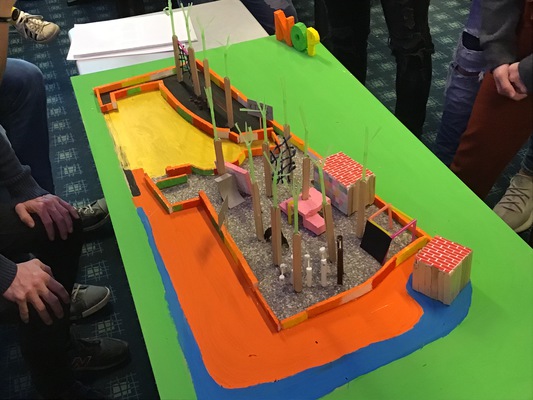Student Exchange the Netherlands
On Monday morning, headmaster Anne Leijenaar opened the project week with a word of welcome. After this, the students were given a small introduction about the general idea of the project and they received a bag with a notebook, a pen and a folder for the handouts. Then it was time to go to the gym. Here, students and teachers participated in games, inspired by the principles of ‘project adventure’. They include ice-breakers and get-to-know-you games, warm-ups and energisers, trust exercises and group problem-solving activities. It challenges students to work co-operatively, challenge themselves in a supportive environment, improve self-esteem and learn creative approaches to problem-solving.
At the end of the morning, the group continued its way to the city council. Alderman Wiemer Haagsma welcomed the students and told them interesting (cultural and agricultural) facts about life in the Noordoostpolder. Social worker Wytse Wierda from Carrefour explained that the local skatepark had moved to a new location. However, while still very popular amongst young people, a new freerun course has not yet been re-built. The city council is willing to seriously look into new ideas for a new freerunning course. This provides our international group of students with an assignment: ‘Design a new, challenging freerun parkour course that meets legal requirements and other criteria.’
During that whole week, students worked in mixed groups. Inevitably, this improved and developed their collaboration skills, creative skills, English fluency and many more. Students experienced freerunning themselves, did the research (e.g. checking and measuring the appointed location), make sketches and create a scale-models. All of this resulted in group presentations for local aldermen, two sportsmen from Freerun Academy and other professionals in the field.
The Dutch Emelwerda College offers its students the option to choose for a course called ‘Technasium’. In this course, students work in groups and for real clients. During this project week, students worked according to the principles of Technasium. This approach is very different from traditional learning. There is much freedom within projects and teachers are there to coach and correct only if necessary. Students can use laptops, iPads, drawings materials, machinery and a 3D printer.
So far, the project has already drawn the attention from the local newspaper(s) and the first article has been published.
Technasium is a stream in the secondary educational system of the Netherlands. It can be chosen by VWO and HAVO students. Scientific subjects form the basis of this teaching method. It can be compared to grammar school, which includes the subjects Latin and Greek. Technasium, however, includes the examination subject “Research and Design” (Dutch: "Onderzoeken en Ontwerpen"). Students can start this course from the first year to the fourth year of high school. Schools are recommended to schedule about 4–6 hours of Research and Design class a week, but this may vary among different high schools. In the first three years, the course is optional and is an addition to the standard curriculum. To prevent the students from having too many study-hours, the schools are free to drop certain other subjects.